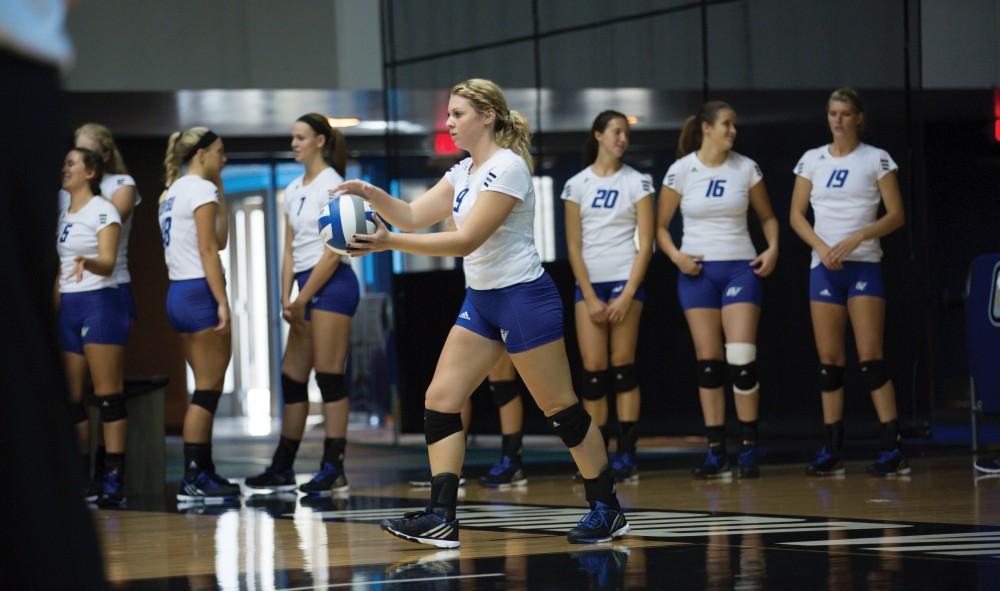Two setters vie for starting spot for GV

GVL / Kevin Sielaff Katie Olson (9) prepares to serve the ball. The Laker Vollyeball team squares off against SVSU Sept. 19 inside the Fieldhouse Arena in Allendale. The Lakers defeated SVSU by a margin of 3-1.
Sep 24, 2015
In the constant changing landscape of college athletics, the Grand Valley State volleyball team was fortunate in 2012 when it only lost three seniors going into the 2013 season. But then the inevitable happened.
Following the 2014 season, GVSU graduated five players – and with them quite a bit of star power – causing the program to lose more than half of its starting lineup.
While the emergence of freshmen hitters Staci Brower and Brooke Smith has eased some of the pain, head coach Deanne Scanlon needed a replacement for Kaitlyn Wolters, the 2014 GLIAC Player and Setter of Year and a two-year AVCA Honorable Mention All-American.
Now, 10 games into the season, Scanlon hasn’t found one potential alternative, but two.
The 6-2 formation gives Scanlon the flexibility to rotate the setter position between sophomore Katie Olson and freshman Taylor Stewart.
“(The 6-2 formation) allows us to have a big blocker or another attacker in the front versus one of (the setters) playing all six rotations,” Scanlon said. “For right now, I think that’s the best option for us. It allows us to play a lot more kids and see those competing for spots.”
In this formation, two setter positions in the rotation are staggered, so one is always in the back row. Whenever a setter position rotates to the front row, they get subbed out for another attacker, then the setter returns once their original spot moves to the back row.
GVSU previously used the 5-1 formation, as the Lakers had the luxury of keeping Wolters on the court when she rotated to front row because of her height and blocking ability.
Olson and Stewart, both listed at 5-feet-6-inches, don’t have those same qualities.
“(Wolters) was a very opposing block and she could be offensive as well by getting kills,” Scanlon said. “Our setters are a little bit smaller, so blocking-wise they would be a liability in the front row right now, and by not having the size of a taller setter they don’t have that offensive threat.”
The tandem of Olson and Stewart has evenly split starts so far with each getting five. Stewart has played in every set, while Olson sat out the second match of the season against Carson-Newman.
At Utica Eisenhower High School, Stewart earned several all-conference, all-county and all-region awards. She currently leads GVSU in assists (250) and is ranked 10th-best in the GLIAC, averaging 7.14 assists per set.
The early success is helping Stewart steadily adapt to the college game.
“There is a lot more expected out of you,” Stewart said. “It’s been faster, more intense, more pressure, bigger hitters and harder swings.”
From server specialist to setter, Olson has dished out 136 assists, averaging 4.53 per set. Her numbers are a sizeable improvement from the 36 assists in 35 sets she had last season as a freshman behind Wolters.
“With Kait (Wolters) being the better player and being an All-American, I learned from her a lot last year,” Olson said. “So, this year, I knew it was my time to come out and play.”
Scanlon expressed interest in eventually switching back to the 5-1 formation if Olson or Stewart emerges a leader and the team consistently performs well behind them.
For now, however, the two-setter approach fits with having an abundance of young, talented hitters. It’s also a system that worked for Scanlon in the past – the 2005 GVSU national championship team used the 6-2 formation for the majority of the season.
While anything is possible, it’s questionable to suggest that two underclassmen could lead a team to national championship status immediately.
Regardless, taking it one rotation at a time, both players are getting valuable experience to prepare them for the future – whatever it might hold.























